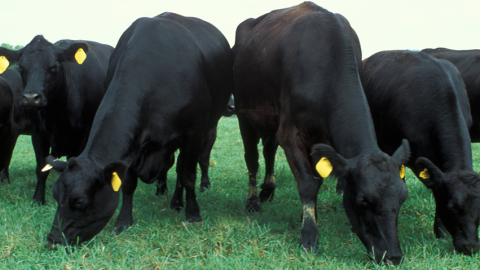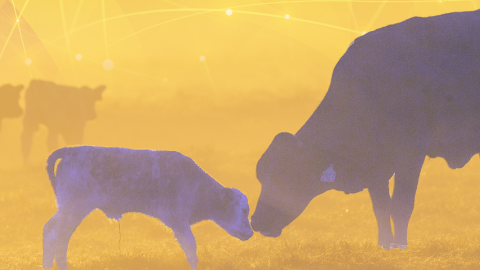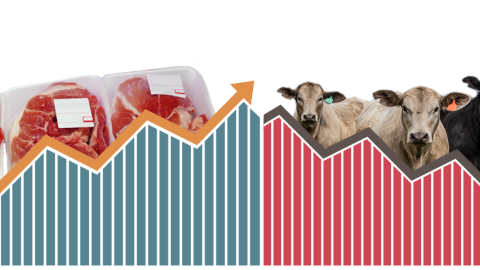This page provides information on:
- Periodic and scheduled ERS publications and data on cattle and beef
- Recent ERS publications relating to cattle and beef
With the largest fed-cattle industry in the world, the United States is also the world's largest producer of beef, primarily high-quality, grain-fed beef for domestic and export use. Nevertheless, the United States is a net beef importer, purchasing lower-value, grass-fed beef destined for processing. The U.S. industry is roughly divided into two production sectors: cow-calf operations and cattle feeding. Because the cattle/beef industry depends on feed grains, grain supplies and prices affect beef production. For a comprehensive overview of the cattle and beef industry, including production, policy, and trade, see Sector at a Glance.
USDA's ERS conducts research and analyses on the livestock market, including the cattle and beef market, and provides a monthly industry outlook as well as current and historical data covering supply, use, prices, and trade of cattle and beef.
Periodic, Scheduled Outputs
- The Livestock, Dairy, and Poultry Outlook (LDP), a monthly report that provides supply and use projections for U.S. livestock, dairy, and poultry markets based on the most current USDA, World Agricultural Outlook Board, World Agricultural Supply and Demand Estimates.
- WASDE at a Glance, a monthly interactive visualization that provides key data and highlights from USDA's World Agriculture Supply and Demand Estimates (WASDE) on livestock and dairy as well as field crops.
- Livestock and Meat Domestic Data, a monthly data product that contains current and historical data on beef, veal, poultry, and pork, including production, supply, utilization, and farm prices.
- Livestock and Meat International Trade Data, a dataset that contains monthly and annual data for imports and exports of live cattle, hogs, sheep, and goats, as well as for beef and veal, pork, lamb and mutton, chicken meat, turkey meat, and eggs. The tables report physical quantities, not dollar values or unit prices. Data on beef and veal, pork, and lamb and mutton are on a carcass-weight-equivalent basis. Breakdowns by country are included.
- Meat Price Spreads, a monthly data set that provides average price values, and the differences among those values, at the farm, wholesale, and retail stages of the production and marketing chain for selected cuts of beef, pork, and broilers. In addition, retail prices are provided for beef and pork cuts, turkey, whole chickens, eggs, and dairy products.
- Commodity Costs and Returns, a data product that provides annual estimates of production costs and returns for major field crops, milk, hogs, and cow-calf.
- USDA's Agricultural Baseline Projections, an annual report published in February that offers 10-year projections from USDA's annual long-term projections analysis. The associated database covers projections for the four major feed grains (corn, sorghum, barley, and oats) in addition to the other major feed crops and livestock.
Recent ERS Publications Relating to Cattle and Beef
ERS also releases reports covering domestic and global conditions, trends, and policies that affect poultry supply, demand, prices, and trade in the cattle and beef sector. Recent ERS reports relating to cattle and beef include:
- “An Assessment of U.S. Beef Imports" in Livestock, Dairy, and Poultry Outlook: July 2023 A majority of U.S. beef imports are destined for blending into ground beef, but a close look at trade data reveals some of the dynamics about the mix of imported beef products and how they have changed over time. About one-third of all imports are frozen boneless manufacturing trimmings originating from Australia, New Zealand, Brazil, and other smaller suppliers. Imported fresh beef has increased in volume over the last decade as imports of primals and subprimals from Canada and specialized cuts from Mexico have increased. Imports are forecast to increase through 2024 as domestic beef production declines, but other factors could shift imports away from recent patterns. (LDP-M-349, July 2023)
- Concentration and Competition in U.S. Agribusiness This report details issues surrounding market concentration in agribusiness, particularly in three agribusiness sectors where concentration has increased over time: seeds, meatpacking, and food retail. Market concentration and its impact on competition have attracted growing public scrutiny. Critics argue that many industries have grown too concentrated, with fewer firms competing with one another and a consequent weakening of competition. The report covers the consolidation in each of these industries, explains the driving forces behind increased concentration, and examines public policies aimed at encouraging competition, focusing on the implementation of merger policy. (Report No. EIB-256, June 27, 2023)
-
U.S. Trade Performance and Position in Global Meat, Poultry, and Dairy Exports
The emergence of new animal product suppliers, trade agreements and barriers, changes in consumer preferences, and growth in consumption in developing markets influence the global trade performance of U.S. agricultural commodities. This report analyzes the position and competitiveness of U.S. meat, poultry, and dairy exporters relative to global competitors from 2000 to 2021. (Report No. ERR-312, April 11, 2023).
-
Rotational Grazing Adoption by Cow-Calf Operations
This report provides details on how frequently or “intensively” grazing operations rotate livestock between paddocks (fenced grazing areas), key system characteristics such as average paddock size, and how outcomes such as stocking density and cost relate to system characteristics. Rotational grazing is a management practice in which livestock are cycled through multiple paddocks to manage forage production, forage quality, and environmental quality. USDA’s Natural Resources Conservation Service (NRCS) and other organizations promote rotational grazing as an important practice for providing improved environmental outcomes, relative to conventional grazing, in which livestock are not rotated between grazing areas. Despite the breadth of support for rotational grazing, only limited information is available on its prevalence and the variation in how producers implement the practice. The report finds that about 40 percent of cow-calf operations use rotational grazing, but less than half of those are under intensive systems. Rotational grazing is most common in the Northern Plains/Western Corn Belt and Appalachian regions. (Report No. EIB-243, November 01, 2022).
-
Quantifying Consumer Welfare Impacts of Higher Meat Prices During the COVID-19 Pandemic
In this report , U.S. households’ meat purchases at retail stores for at-home consumption during the Coronavirus (COVID-19) pandemic are examined and compared with those before the virus outbreak. While the U.S. food system has been largely able to maintain operations and provide consumers with the variety of foods they desire since the COVID-19 pandemic began, U.S. households faced sharply higher food prices for many staple items, especially meat in 2020. (Report No. ERR-306, April 28, 2022).
- Federal Natural Disaster Assistance Programs for Livestock Producers, 2008–2016 This report provides an analysis of three disaster assistance programs for livestock administered by the Farm Service Agency and reveals regional differences in payment delivery and how outlays vary by year and program. (Report No. EIB-187, January 2018)
- Three Decades of Consolidation in U.S. Agriculture This report covers how crop production has seen a widespread and persistent shift of acreage and sales to larger farming operations over the last three decades. Some livestock sectors have seen dramatic structural change, but consolidation has been modest or nonexistent in pasture/grazing land and in the associated cow-calf sector. Consolidation has been facilitated by increased farm-level commodity specialization. (Report No. EIB-189, March 2018)



